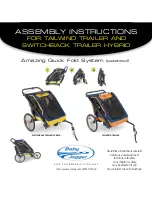
29
First day use; check tightness of nuts & bolts hourly ►
Moving from Transport to Work
Reverting to the work position is basically a reversal of the previous work to transport
procedure.
Remember to open both lift lock taps before attempting to move
the machine out of the transport position.
OPERATING SPEED
Engaging Drive
Ensure the rotor control is in the ‘stop’ position before engaging the PTO.
Allow the hydraulic oil to circulate for a minute or so before operating armhead controls.
Move the flail head into a safe working position just clear of the material to be cut.
Increase engine speed to a high idle and start the rotor
–
after initial ‘surging’ the rotor
will run at an even speed.
Carefully lower the flail head into the work area and begin work.
Tractor Forward Speed
The material being cut will determine the tractor
forward speed. Forward speed can be as fast as
that which allows the flail head sufficient time to cut
the vegetation both efficiently and neatly.
If forward speed is too fast this be indicated by over
frequent operation of the breakaway system, a
‘fall
off
’ in tractor revs and poor untidy finish to the work
leaving ragged uncut tufts and poorly mulched
cuttings.
‘Running In’ a New Machine
During
the first day’s work with a new machine it is
recommended that the forward speed of the tractor
is restricted to 3km/hr
(2mph)
maximum; this will
permit machine components to
‘bed in’ and allow
the operator to become familiar with the controls
and their response under working conditions whilst
operating at a relatively slow speed. If possible,
select a first
day’s work that affords mainly light to
average cutting with occasional heavy duty work
–
during this period check tightness of nuts and bolts
every hour, retightening as and when required.
Summary of Contents for P70S
Page 7: ......
Page 13: ......
Page 15: ......
Page 20: ...4 Operating Dimensions...
Page 35: ...19...















































